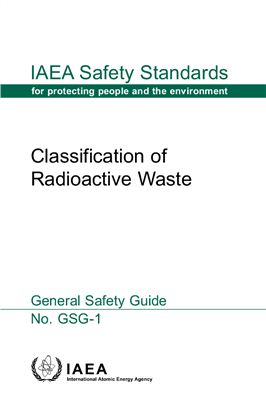Vienna : Inteational Atomic Energy Agency, 2009. 61 p.
IAEA safety standards series no. GSG-1
ISSN 1020–525X
ISBN 978–92–0–109209–0
The objective of this Safety Guide is to set out a general scheme for classifying radioactive waste that is based primarily on considerations of long term safety, and thus, by implication, disposal of the waste. This Safety Guide, together with other IAEA safety standards on radioactive waste, will assist in the development and implementation of appropriate waste management strategies and will facilitate communication and information exchange within and among States. Disposal is considered the final step in the management of radioactive waste, as stipulated in Safety Requirements publications on predisposal management of radioactive waste and disposal of radioactive waste.
The Safety Guide identifies the conceptual boundaries between different classes of waste and provides guidance on their definition on the basis of long term safety considerations. While the usefulness is recognized of classification schemes for the safe operational management of radioactive waste, including the transport of waste, such schemes are subject to different considerations and are not addressed in this Safety Guide.
This Safety Guide provides guidance on the classification of the whole range of radioactive waste: from spent nuclear fuel, when it is considered radioactive waste, to waste having such low levels of activity concentration that it is not required to be managed or regulated as radioactive waste. This Safety Guide covers disused sealed sources, when they are considered waste, and waste containing radionuclides of natural origin. The recommendations in this Safety Guide are applicable to waste arising from all origins, including waste arising from facilities and activities, waste arising from existing situations and waste that may arise from accidents.
The classification scheme developed in this Safety Guide is focused on solid radioactive waste. However, the fundamental approach could also be applicable to the management of liquid and gaseous waste, with appropriate consideration given to aspects including the processing of such waste to produce a solid waste form that is suitable for disposal.
IAEA safety standards series no. GSG-1
ISSN 1020–525X
ISBN 978–92–0–109209–0
The objective of this Safety Guide is to set out a general scheme for classifying radioactive waste that is based primarily on considerations of long term safety, and thus, by implication, disposal of the waste. This Safety Guide, together with other IAEA safety standards on radioactive waste, will assist in the development and implementation of appropriate waste management strategies and will facilitate communication and information exchange within and among States. Disposal is considered the final step in the management of radioactive waste, as stipulated in Safety Requirements publications on predisposal management of radioactive waste and disposal of radioactive waste.
The Safety Guide identifies the conceptual boundaries between different classes of waste and provides guidance on their definition on the basis of long term safety considerations. While the usefulness is recognized of classification schemes for the safe operational management of radioactive waste, including the transport of waste, such schemes are subject to different considerations and are not addressed in this Safety Guide.
This Safety Guide provides guidance on the classification of the whole range of radioactive waste: from spent nuclear fuel, when it is considered radioactive waste, to waste having such low levels of activity concentration that it is not required to be managed or regulated as radioactive waste. This Safety Guide covers disused sealed sources, when they are considered waste, and waste containing radionuclides of natural origin. The recommendations in this Safety Guide are applicable to waste arising from all origins, including waste arising from facilities and activities, waste arising from existing situations and waste that may arise from accidents.
The classification scheme developed in this Safety Guide is focused on solid radioactive waste. However, the fundamental approach could also be applicable to the management of liquid and gaseous waste, with appropriate consideration given to aspects including the processing of such waste to produce a solid waste form that is suitable for disposal.

